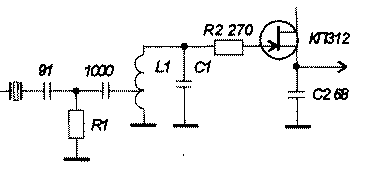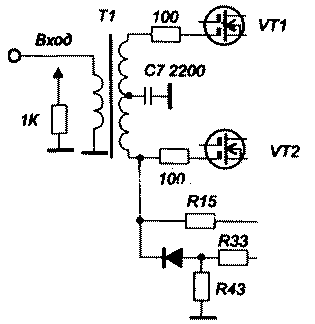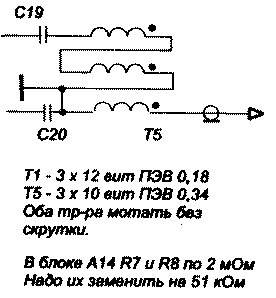Quartz filter matching. Encyclopedia of radio electronics and electrical engineering

Encyclopedia of radio electronics and electrical engineering / Civil radio communications
 Comments on the article
Comments on the article
When I assembled the transceiver for the first time, I could not achieve good matching of the quartz filter with the first stage of the IF, and also get a sufficient gain and low noise. After conducting several experiments and trying out several methods of matching, I settled on the following scheme, Fig.1.

Ris.1
Resistor R1 is equal to the wave impedance of the filter, but it is still desirable to select it directly in the IF circuit. The circuit L1, C1 is equivalent to the oscillating circuit L1, C6 in the intermediate frequency amplifier of the transceiver. The tap should be made from 1/6 of the turns, counting from the grounded end. Resistor R2 sets the bias at the gate of the field-effect transistor, and capacitor C2 is selected for maximum gain. An increase in capacitance C2 to 100 pF leads to an increase in both gain and noise, and its further increase only leads to an increase in noise.
A few general recommendations
(The reference designations of the RA3AO transceiver are preserved in the text)
** In block A18, instead of resistor R1, a resistance of 50 Ohm +/-10 Ohm should be put, and capacitor C5 should be connected in series with the EMF winding (from either end). In block A21, to improve the symmetry of the circuit, the input circuit should be changed, Fig. 2

Ris.2
and for better matching with a coaxial cable, it is necessary to redo the output transformer, Fig.3.

Ris.3
** To increase the brightness of the dots on the light panel in block A7 (ChTM), resistor R42 should be connected to the +50 V power bus.
** You can improve the balance of the pointer device to "0" if you change the resistor values in block A13: R6 = 3,9 kOhm and R5 = 1,8 kOhm.
** Sometimes there is not enough supply voltage for the band-pass filter relay, especially when the mains voltage is low. This drawback can be eliminated by changing the values of resistors R10 ... R6, R9 ... R19 in block A22 by 1,5 kOhm.
** You can eliminate the self-excitation of the output stage if you swap the ends of the input winding of the transformer T21 in block A1. If it does not help, then you should shunt it with a 1 kOhm resistor and again select the phasing of the primary winding.
Literature
1. V. Drozdov "Amateur KB transceivers".
2. S. Bunimovich, L. Yaylenko "Technique of amateur single-band radio communication", 1970
Author: S.Volkovinsky, RA9FOR, Perm; Publication: N. Bolshakov, rf.atnn.ru
 See other articles Section Civil radio communications.
See other articles Section Civil radio communications.
 Read and write useful comments on this article.
Read and write useful comments on this article.
<< Back
 Latest news of science and technology, new electronics:
Latest news of science and technology, new electronics:
The world's tallest astronomical observatory opened
04.05.2024
Exploring space and its mysteries is a task that attracts the attention of astronomers from all over the world. In the fresh air of the high mountains, far from city light pollution, the stars and planets reveal their secrets with greater clarity. A new page is opening in the history of astronomy with the opening of the world's highest astronomical observatory - the Atacama Observatory of the University of Tokyo. The Atacama Observatory, located at an altitude of 5640 meters above sea level, opens up new opportunities for astronomers in the study of space. This site has become the highest location for a ground-based telescope, providing researchers with a unique tool for studying infrared waves in the Universe. Although the high altitude location provides clearer skies and less interference from the atmosphere, building an observatory on a high mountain poses enormous difficulties and challenges. However, despite the difficulties, the new observatory opens up broad research prospects for astronomers. ... >>
Controlling objects using air currents
04.05.2024
The development of robotics continues to open up new prospects for us in the field of automation and control of various objects. Recently, Finnish scientists presented an innovative approach to controlling humanoid robots using air currents. This method promises to revolutionize the way objects are manipulated and open new horizons in the field of robotics. The idea of controlling objects using air currents is not new, but until recently, implementing such concepts remained a challenge. Finnish researchers have developed an innovative method that allows robots to manipulate objects using special air jets as "air fingers". The air flow control algorithm, developed by a team of specialists, is based on a thorough study of the movement of objects in the air flow. The air jet control system, carried out using special motors, allows you to direct objects without resorting to physical ... >>
Purebred dogs get sick no more often than purebred dogs
03.05.2024
Caring for the health of our pets is an important aspect of the life of every dog owner. However, there is a common assumption that purebred dogs are more susceptible to diseases compared to mixed dogs. New research led by researchers at the Texas School of Veterinary Medicine and Biomedical Sciences brings new perspective to this question. A study conducted by the Dog Aging Project (DAP) of more than 27 companion dogs found that purebred and mixed dogs were generally equally likely to experience various diseases. Although some breeds may be more susceptible to certain diseases, the overall diagnosis rate is virtually the same between both groups. The Dog Aging Project's chief veterinarian, Dr. Keith Creevy, notes that there are several well-known diseases that are more common in certain breeds of dogs, which supports the notion that purebred dogs are more susceptible to disease. ... >>
 Random news from the Archive Random news from the Archive Dream zone found in brain
23.04.2017
A large area of the posterior cortex changes its electrical activity as soon as we start dreaming.
Sleep is divided into several stages: REM sleep (REM sleep, or rapid eye movement phase) and non-REM sleep (which, in turn, consists of several more phases). For a long time it was believed that dreams come only in REM sleep - it’s not for nothing that the eyes move during it.
However, over time, it turned out that dreams are dreamed not only in REM sleep, but also in slow sleep (for example, a person may dream of something, although according to the electroencephalogram (EEG), he did not have any REM sleep at all).
Neuroscientists have long been trying to figure out whether dreams obey some laws, which areas of the brain turn on the dream mode, etc. Researchers from the University of Wisconsin-Madison write that they were able not only to find a region in the brain that “turns on” dreams, but also predict when a person will dream something. The experiment involved several dozen people who were asked to sleep in a laboratory with a small device for recording electrical brain waves on their heads. Volunteers were woken up at different times, asked if they dreamed anything and if they could remember any details of it, and their answers were compared with what the EEG showed.
It turned out that dreams have a well-defined electrorhythmic "handwriting": when a person began to dream about something, the intensity of low-frequency waves dropped, and the intensity of high-frequency waves, on the contrary, increased, and this happened in a certain area in the posterior lobes of the cortex. "Dream" changes in the electrical activity of the brain took place not only during REM sleep, but during non-REM sleep as well. By monitoring the “dream zone,” neuroscientists have been able to predict fairly accurately whether a person is dreaming or not. By the way, it turned out that dreams accompany 95% of REM sleep and 71% of slow sleep.
The area of the cortex associated with dreams turned out to be quite extensive, and in itself it consists of a number of areas with certain functions. The content of sleep depended on the area in which the electrorhythmic changes occurred: for example, if the intensity of high frequencies increased in Wernicke's zone, which is involved in the interpretation of speech, then the awakened person then told that someone was saying something in his dream.
For the time being, it would probably be premature to assert a causal relationship between dreams and the activity of the "sleepy cortex" - it may be that the change in the frequency of brain waves does not so much trigger the mechanism of dreams, but only accompanies it. One way or another, the more we know what happens in the brain during dreams, the more we will learn not only about the nature of sleep, but also about the nature of consciousness in general.
|
 Other interesting news:
Other interesting news:
▪ Sleep protects against colds
▪ solar stop
▪ Origin of gold
▪ Cleansing the blood instead of a heart transplant
▪ The water was heated to a record temperature
 News feed of science and technology, new electronics
News feed of science and technology, new electronics
 Interesting materials of the Free Technical Library:
Interesting materials of the Free Technical Library:
▪ site section Measuring equipment. Article selection
▪ Article Toaster. History of invention and production
▪ article Which musician was not picked up by the crowd after jumping off the stage and then robbed? Detailed answer
▪ Brussels sprout article. Legends, cultivation, methods of application
▪ article Two-channel narrow-band VCO for tuning the frequency response of quartz filters. Encyclopedia of radio electronics and electrical engineering
▪ article Guessing the planned number on the dial. Focus Secret
 Leave your comment on this article:
Leave your comment on this article:
 All languages of this page
All languages of this page
Home page | Library | Articles | Website map | Site Reviews

www.diagram.com.ua
2000-2024







 Arabic
Arabic Bengali
Bengali Chinese
Chinese English
English French
French German
German Hebrew
Hebrew Hindi
Hindi Italian
Italian Japanese
Japanese Korean
Korean Malay
Malay Polish
Polish Portuguese
Portuguese Spanish
Spanish Turkish
Turkish Ukrainian
Ukrainian Vietnamese
Vietnamese



 Leave your comment on this article:
Leave your comment on this article: